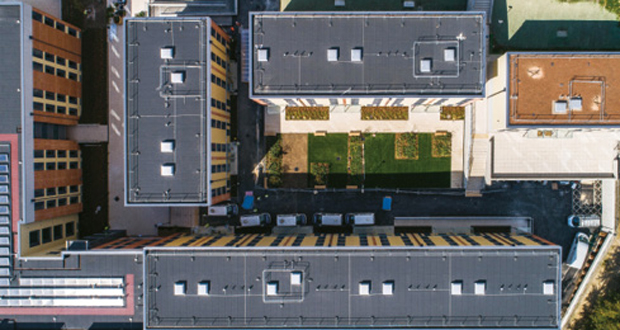 Conor Logan, Colt’s Technical Director, with a guide to maintaining aov (automatic opening vent) maintenance
Conor Logan, Colt’s Technical Director, with a guide to maintaining aov (automatic opening vent) maintenance
An ‘AOV’ or ‘Automatic Opening Vent’ is a smoke or fire vent that will open and close automatically when triggered by a control system to help vent smoke or heat out of a building in the event of a fire.
As such, they are considered life safety systems and form an extremely important part of a building’s fire safety strategy. They are predominantly installed on the roof or side of the building to clear smoke from corridors or common areas such as lobbies and are also used to protect escape routes (such as stairwells) in residential or commercial buildings. They may also be required in buildings that feature open-plan interiors (such as atria) or in large single-storey buildings such as warehouses or factories where smoke would otherwise just build up indefinitely.
They not only help people escape from a building safely, but also help to improve the conditions in the building for firefighters who are entering it – with better visibility and improved air quality they can reach the fire quickly and safely to get the situation under control.
AOVs are typically activated by a smoke or heat detector, either directly or from a smoke detection system or possibly a fire alarm system.
WHO IS IN CHARGE OF MAINTAINING AOVS IN A BUILDING?
Under the RRO (The Regulatory Reform (Fire Safety) Order 2005) it is the role of the ‘Responsible Person’ to ensure that all fire safety systems in the building are maintained properly and in good working order.
Most commonly, the ‘Responsible Person’ will be either an employer, the owner or landlord of the building or anyone else who holds a level of control of the management and/or upkeep of the building. These titles could include a facility manager or building manager.
Typically, there will be more than one ‘Responsible Person’. If this is the case, they must all work together to fulfil their duties.
HOW OFTEN SHOULD AOVS BE SERVICED AND TESTED?
In order to meet the requirements of the RRO and BS: 7346-8, AOVs need to be serviced by a competent person at least once a year.
Additionally, they should be tested on a weekly, monthly and six-monthly basis. The weekly and monthly checks can be done by a person who is familiar with the system (such as the Responsible Person), but the six-monthly tests need to be carried out by a third-party certified smoke control specialist to ensure compliance.
If any of the vents are found to be non-functioning during routine testing, or have become damaged, immediate action needs to be taken to remedy the faults and/or failures.
If it is not possible to repair or replace the faulty components immediately, the ‘Responsible Person’ should carry out a risk assessment to determine if any additional measures should be put in place until full performance is restored – these might include putting in place a waking watch or relocating the building occupants or employees until repairs can be carried out.
HOW DO YOU MAINTAIN AOV SYSTEMS?
At weekly checks and tests, it should be determined that all vents are opening and closing correctly when activated and that any fans in the system are running at the required speeds. Any back-up generators also need to be checked and tested accordingly. Any faults on the control panel should be investigated and cleared or reported. Likewise, anything unusual in the system operation should also be reported and dealt with, for example, very slow damper operation or an unusual fan/motor noise.
For monthly maintenance checks, it should be checked whether the back-up power supply automatically kicks in if the system’s primary power supply is cut off. Depending on a number of factors, the back-up power supply may be required for anything between four hours and 72 hours. The back-up time depends on:
- the type of power source
- the type of system
- the building use
- the presence of on-site maintenance or emergency call out contract
More detail is available from EN 12101-10 and engineers should be fully equipped to test battery health.
At the six-monthly checks, your smoke control maintenance provider should be doing a full functionality check which takes into consideration cause and effect, checking the correct airflows, opening and closing times, battery charge rates, motor resistance levels, water tightness and more.
Your annual maintenance visit will include all the above as well as additional performance tests. To verify that the system is still performing at the level required, a certificate will be issued to you at this time.
COMPLETE SMOKE CONTROL MAINTENANCE
Thorough smoke control maintenance by a competent specialist is crucial to keeping your building and its occupants safe. If you have a building with AOVs and need help with checking or maintaining them, ensure you only consult the experts.
In association with www.coltinfo.co.uk






